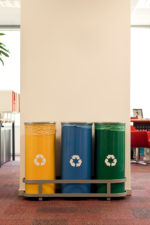Strategies for Greener Living
Sure, you’ve heard about the effects some of our everyday habits have on the environment, whether it is driving our cars around town or heating every square inch of our homes. But did you know these “big” things make up only a relatively small piece of the overall carbon footprint impact?
Approximately forty-two percent of our society’s carbon emissions come from the products we use, and the raising or making, transporting, and disposing of the food we eat. Surprising, huh?
Fortunately, there are simple things we can easily do to help lessen our carbon footprint and, by extension, the effect on the environment. Give these easy eco-friendly ideas a try to not only live greener but to save money, too!

Simplify Shopping
Paper or plastic? Neither
Rather, take reusable shopping bags with you when you head to the store. This will decrease energy use and also harmful emissions produced by manufacturing single-use shopping bags (paper or plastic).
Thirsty? BYOB
You may not think about it as you’re spending $1 for that bottle of water, but buying three bottles of water per day adds up to about $1,100 per year. Compare that with the roughly 50 cents it costs for the same amount of tap water, and it’s a no-brainer. But there’s more than a cost savings involved here: tap water uses one-thousandth of the energy needed to make the bottled variety.
Go vintage
Manufacturing, shipping, and disposal of new goods contributes to environmental pollution. Rather than only buying new things, rely on thrift stores, yard sales, and hand-me-downs. Not only is this better for the environment, but the thrill of the hunt is pretty fun, too!
Say goodbye to single-serve
Instead of purchasing chips or snacks in smaller, single-serve bags, purchase snacks in bulk and then divide them up in reusable containers to pack for lunches.
Look for plant-based green cleaners
Traditional cleaning products are not only harmful to the environment, they can add dangerous toxins to the air you breathe inside your home, as well. Look for eco-friendly, plant-based cleaners with a list of ingredients. Or, better yet, make your own green cleaners!

Eat Smarter
Eat local
Consider shopping for produce at your local farmer’s market rather than the supermarket. Fruits and veggies sourced locally require less fuel for transportation, support nearby farmers, and are fresher, thanks to less travel time.
Cut back on meat
Raising livestock is resource-intensive and accounts for double the greenhouse gas emissions compared to animal-free meals. Did you know incorporating one meat-free meal into your diet each week has the same environmental impact as driving a hybrid car?
Start a compost pile
Composting helps cut energy use and carbon emissions from processing waste. And, as a bonus, it creates dense, nutrient rich-soil perfect for feeding your garden. To help control the smell, consider collecting your compost in a closed container. Be sure to check your local regulations on compost guidelines.

Go Green at Home
Lighten up
Fluorescent light bulbs or LEDs create more light while also using less power. Replace old incandescent bulbs with newer, energy efficient bulbs to reduce your carbon footprint—and enjoy the savings.
Use ENERGY STAR® appliances
Energy Star is the EPA’s program that helps Americans save money and use less energy. Always look for appliances that bear the Energy Star seal, to lessen the negative effects on the environment. For instance, switching to an Energy Star-certified TV reduces carbon dioxide emissions by forty-six pounds over the lifetime of the product!
Insulate and seal your home
This will not only cut carbon emissions from the energy demand, but it will also help maintain comfortable temperatures in your home throughout the year—and helps lower your energy bill!

Rethink Your Commute
Take the bus
Public transit is more fuel-efficient than cars and is estimated to reduce annual carbon dioxide emissions by thirty-seven million metric tons. Bonus: taking the bus also frees up your commute time to let you do something you enjoy, such as reading or catching up with your friends and family.
Walk or bike
Not only is this option eco-friendly, but it is better for your health, too! This green option burns 250 to 550 calories per hour and keeps exhaust-producing cars off the road. The Earth—and your waistline—will thank you.
Rethink air travel
Conduct business via phone or video conference. If long-distance travel is a must, consider going old school by taking the train to cut emissions of carbon dioxide and other pollutants.
Explore the option of flex time
Check with your employer to see if you have the option of utilizing flex time. Some companies will let you work from home, either part-time or full-time, if they can see a benefit for the company, as well. By working from home, you will eliminate your commute altogether, leading to a positive impact on the environment.
Carpool
If flex time is not an option for you and you must go into the office, consider carpooling with coworkers who live nearby. This reduces the number of cars on the road, which will reduce the pollutants and emissions released into the air.































